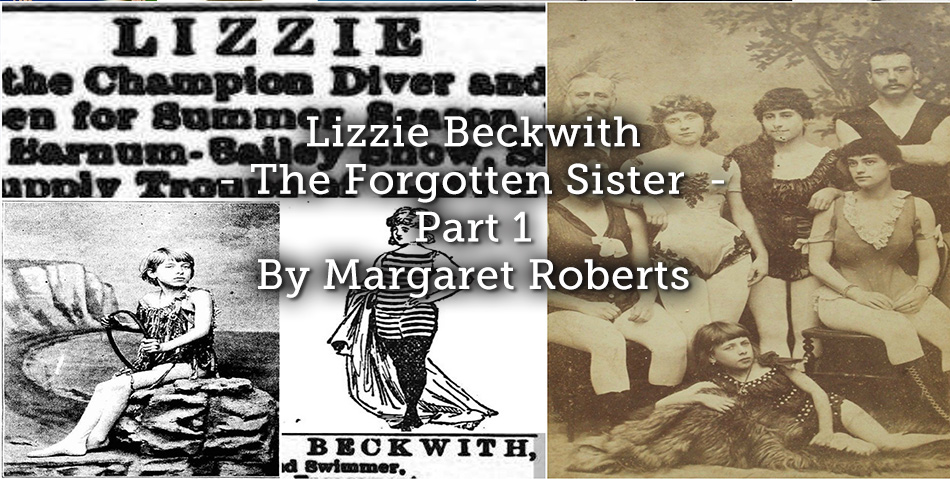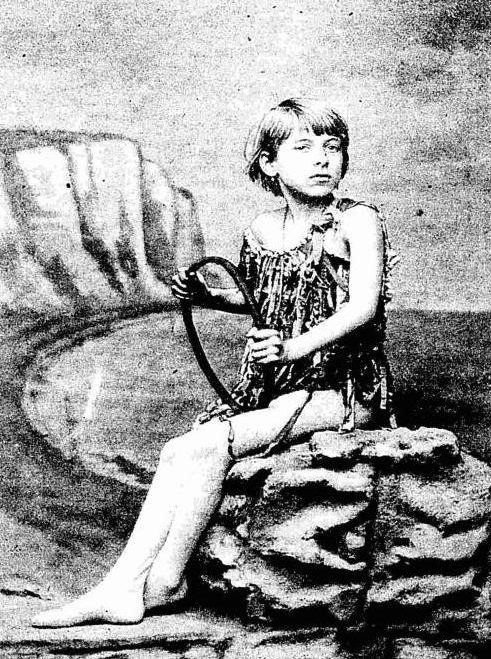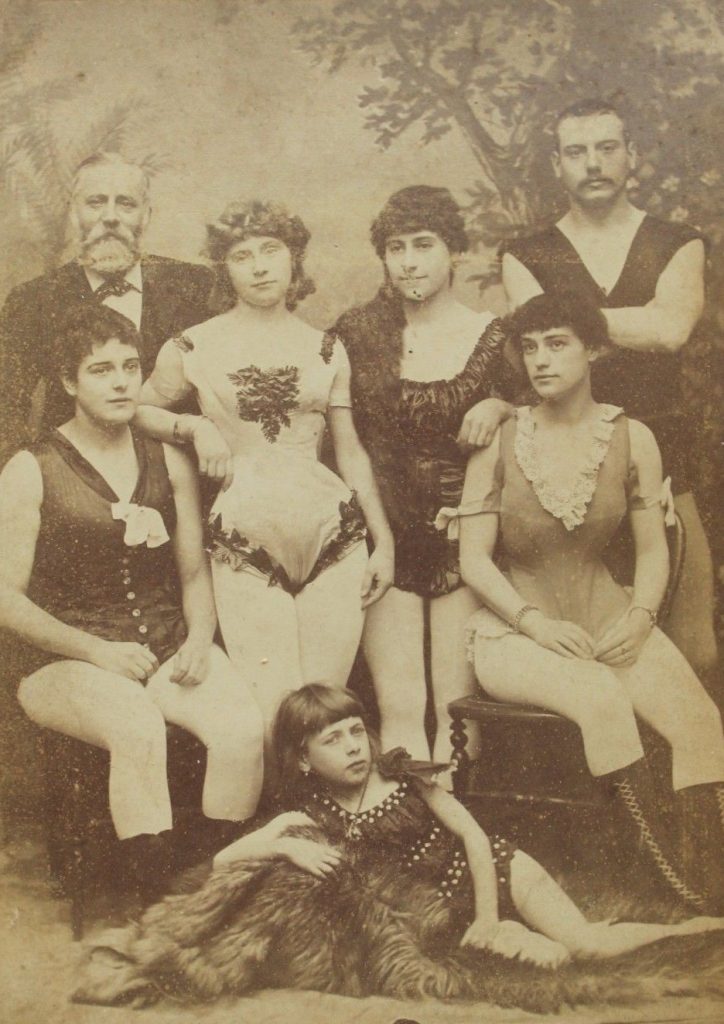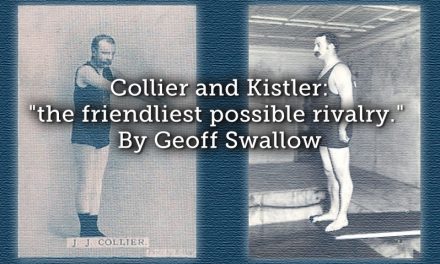The name Beckwith is integral to the story of swimming in the 19th century and that of Agnes Beckwith, central to any discussion regarding the history and development of women’s participation in the sport. Less well-known is that of Lizzie Beckwith, half-sister to Agnes, whose short and comparatively sad life-story, illustrates the intersection between sport and entertainment that was a feature of female natationists in this period.
Born Elizabeth Agnes on 28th August 1878 to “Professor” Fred Beckwith and his second wife Elizabeth Ainley Burgess Osland, Lizzie first performed at the age of three in January 1885. The press at the time reported that:
‘The Beckwith Swimming Entertainment at the Royal Aquarium
is now rendered additionally attractive by the appearance of the
‘infant phenomenon’, Lizzie Beckwith, a baby swimmer, about
3 years of age, of extraordinary ability.’
A few years later she was regularly appearing in conjunction with her older sister and brothers, the world-renowned Agnes, Willie and Charles, along with other members of the Beckwith troupe. Referred to as the ‘smallest swimmer in the world’ by her ever entrepreneurial father, these family entertainments were described as very popular, drawing large audiences to the Royal Aquarium. Lizzie, sometimes referred to as Nellie, also joined the family when they took their aquatic show on the road. She executed ornamental feats such as swimming with her hands and legs tied, demonstrations of saving life from drowning and comic aquatic sketches both in local swimming pools and crystal tanks on the stages of the provinces. By 1888 her younger brother Bobbie, aged four, and six-year-old nephew Frederick also joined the troupe.
- Nellie Beckwith aka Lizzie – Hearth and Home 6th August 1891
In June of 1889 her father filed for a judicial separation and divorce from her mother Elizabeth on the grounds that she was ‘a very violent and drunken woman’ who had treated Fred with ‘great unkindness and cruelty’, adding further insult to injury by pawning his property in order to gain money to buy more alcohol. It was also claimed that she had, on a number of occasions, attempted to stab him with a knife and even broken down a door to a room with a meat chopper, in which he had taken shelter and threatened to murder him. Fred removed Lizzie and Bobbie from the house, after a particularly violent attack, in which he had to call upon his son-in-law William Taylor (Agnes’s husband and manager) for protection. Very shortly afterwards Fred acquired a Police Court Summons against his wife and also applied for custody of the children, in the 1891 census both Lizzie and Bobbie are living with their father in Lambeth, while Elizabeth is living in Margate. However it would seem that the divorce was never actually finalised and Elizabeth can be seen appearing with the Beckwith troupe at various times throughout the 1890s. What friction the whole episode must have caused within the family can only be surmised but may perhaps explain why Agnes and Lizzie stop performing together not very long after the death of their father.
Lizzie branches out onto the variety stage as a singer and dancer when she teamed up with troupe member Florrie Newton, together they form a duo which they name the Sisters Beckwith, who, according to press reports – ‘swim as well as they dance’. The next few years bought success for the pair, who, ‘copied by thousands, excelled by none’, were employed in cities and towns across England and Wales as both swimmers and serio/dancers.
On 18th May 1892 a letter from Prof FE Beckwith appeared in The Sporting Life, in reply to a challenge from an unnamed lady who styled herself champion ornamental swimmer of the world. Presumably affronted by such a claim Fred puts down £25 to bind a match against
‘…my little daughter, Lizzie Beckwith, aged 13, to swim the lady
advertised as ornamental champion, any style, any distance,
anywhere or for general excellence, for not less than £100 a-side,
winner to receive all the gate money…’
This was the first of many contests and races that Lizzie took part in over the next few years, her greatest triumph coming in September 1893 over a distance of 220 yards during Captain Boyton’s Water Show. This victory, promoted as the Champion Swimmer of the World Cup, brought forth a plentiful number of challenges from other naiads and her father was kept busy matching his youngest daughter with as many of these matches as he could.
- The Era – 11th August 1894
Ramsgate was one of the more popular venues for the Beckwith family and a typical season, such as that of 1896, saw Lizzie and Florrie, along with the rest of troupe hired for a 14-week engagement with the two young women being advertised as performing two distinct ‘turns’ – Lizzie swimming in the sea and Florrie high diving from the pier and then appearing together in a ‘Grand Tank Performance’ every evening at the Pier Pavilion. At the end of September, the duo were recruited to appear nightly at the Marine Palace of Varieties as the Sisters Beckwith, performing with such success that they were not free to accept any new engagements until November.
Invariably described as the most graceful swimmer in the world and Lady Champion of England Lizzie continued to work with the family troupe and with Florrie, as well as taking part in solo swimming and diving exhibitions and Monte Christo acts as Lizzie Beckwith and soubrette acts on the stage as Beth Osland. However, tragedy was to strike Lizzie when both her father and brother Charles died in quick succession in 1898 and then later in the year her partnership with Florrie was dissolved. Lizzie briefly joined back up with Agnes in 1900 when Barnum and Bailey ‘especially engaged’ both women to appear at Olympia, although as discrete acts rather than together as a duo.
- The Beckwith Troupe – Carte de Visite, Prof Beckwith (far left) Charles Beckwith (far right)Lizzie Beckwith (reclining at front)
Lizzie continued to travel across the country appearing at the Pier Head Ramsgate, giving Crystal tank displays at the Lyric Theatre in Bath, where she ‘takes a prominent place among the performances of the evening and those by her in a Crystal Tank are exceedingly clever. While under water she eats, drinks, sews and executes many other tricks, and earns a well-deserved thunder of applause.’ She further presents a serio and dance act in Bristol’s Tivoli, the Empire in Leicester, Palace of Varieties in Dover, the Empire Palace, Portmouth and the Grand, Gravesend – where she performed her own songs Lucinda and The Cigar-Shop Girl, the latter possibly in homage to her father who once ran a Tobacconists. The Sisters Beckwith briefly re-joined for a performance in Paris in April 1900 and from there to Cambridge, Surbition, Eastbourne and Walthamstow, where at the latter, in December, they performed in the pantomime Babes in the Wood.
The 1901 census contains no record of Lizzie and from February 1901 Florrie (now widowed after a short marriage to comedy artist George Bland) started to appear on the variety circuit as comedienne Florrie Beckwith and later teams up with comic actor Fred Allsop, calling themselves Allsop and Beckwith. There is no mention of Lizzie in the newspapers again until January 1902 where she can be found advertising herself as the ‘daughter of the famous Professor Beckwith’, who had enjoyed a successful winter season with Barnum and Bailey in Paris and advertising for a summer series with the same at the Sales de Fete, again in Paris. It transpires that during her time on the Continent she possibly marries Barnum circus clown and driver William Edward Woolley and together they have two children, a daughter who was born in France in March 1901 and a son born in Marylebone in June 1902. (as of yet any documentary evidence of a marriage has not been uncovered, although the birth of their son is registered as though the couple were married but of course that doesn’t mean anything!) According to reports Lizzie separates from Woolley, who allegedly neglected her and the children, after she discovers that he has a fathered a child by another woman.
- The Era – 11th January 1902
Between 1902 and 1904 Lizzie, who sometime during this period takes up lodgings in the Uxbridge/Shepherds Bush neighbourhoods with her children, is variously employed at her old haunt the Pier Head in Ramsgate as well as in the London area appearing in a Charity Gala in Dulwich and performing at the Westminster Baths. The New Palace of Varieties in Northampton and the Palace at Lincoln see Lizzie returning to her roots, advertised as the ‘Original Tank Performer’ while also demonstrating an ‘acceptable song and dance routine’. She formed a troupe of her own and together they appear at the Wembley Park Lake, the Great Smith Street Baths, Westminster and Battersea Swimming Club in London. Lizzie was also hired as the lady instructor at the Edmonton swimming club in November 1903.
Part two of this article which addresses the latter stages of Lizzie’s life course and career, much of which took place in North America can be read HERE
Article © Margaret Roberts
For more information on the Beckwith family see:
Day, D. Oxford Dictionary of National Biography entry – Frederick Edward Beckwith
Day, D. (2012). ‘“What Girl Will Now Remain Ignorant of Swimming?” Agnes Beckwith, Aquatic Entertainer and Victorian Role Model’. Women’s History Review 21(3), 419-446.
Day, D (2011). Kinship and Community in Victorian London: the “Beckwith Frogs”. History Workshop Journal 71 (1), 194-218










